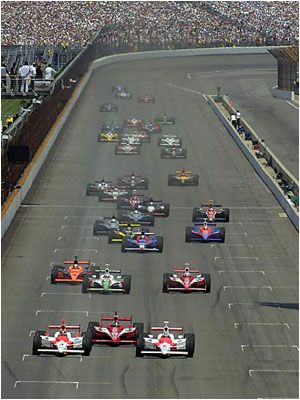With news that there may be a merger between IRL and Champ Car, reported in a previous post, it timely to review how it got to this.
Tony George has customarily been blamed for causing a split in American open wheel racing. The conventional wisdom is that it was just greed that caused the Hulman family to create the IRL.
But, that’s not accurate.
The roots of the split date back to the 1950’s.
Many people are familiar with the story of how Tony Hulman, grandfather of current Indianapolis Motor Speedway president Tony George, rescued the facility after World War Two, eventually building the 500 into the premier American race, international in its participants and fame. At its peak, the 500 was rivaled only by LeMans and the Grand Prix of Monaco.
But, under all of the glitz and high-roller participation, there was always a tension.
That tension existed because a race promoter cannot run races without race cars. In open wheel racing, this has always meant that the 500 and the Indianapolis Motor Speedway were vulnerable to the team owners, as the facility ran but one race per year.
Tony Hulman recognized the problem in 1955 when the United States Auto Club – USAC – and became the sanctioning body for the 500. Though ostensibly independent of the Speedway and Hulman family, the reality was that Hulman had absolute control of USAC.
The public reason for creating USAC was that the American Automobile Association had announced that it would no longer serve as the sanctioning body for auto racing in the United States.
But, its primary purpose was somewhat broader.
USAC was formed to give Hulman control of the various other races that were run by the teams which also ran the Indianapolis 500.
By controlling all of these races, Hulman made it far more difficult for the teams of the day to form a cohesive united front in dealing with any of the individual tracks, but most especially in dealing with the Speedway.
That model continued along without apparent problems until the 1980’s.
By that time, Roger Penske was heavily involved in open wheel racing and, in particular, the Indianapolis 500. Even then, Penske was a fabulously wealthy man, a self-made multimillionaire. In 1968, he had opened the Michigan International Speedway. He had long-standing business and financial ties with General Motors, Porsche, and Mercedes-Benz. In 1988, he created a joint venture with GM by which he effectively acquired Detroit Diesel.
Along with Penske, other men of self-made wealth and entrepreneurship were, by this time, also team owners at the Speedway.
These were men were accustomed to dealing with large dollars and large corporations, men who had more money than the Hulman family and who knew how to take a short-term loss to achieve a long-term gain.
These were the men who controlled all of the top tier teams running the Indianapolis 500.
In 1979, Championship Auto Racing Teams – CART – was formed, with Dan Gurney as its ostensible chief. In theory, it was based on the model of Formula One, in which Bernie Ecclestone banded together the team owners to get greater say in negotiations with the various tracks.
But, the power behind CART was Penske and the other rich team owners.
Essentially, CART wanted to take over USAC. When USAC didn’t genuflect, CART set itself up as its own sanctioning body and took over sanctioning of all the USAC races run by Indianapolis 500 type cars, except for the 500 itself.
Though CART started out being cooperative with the Indianapolis Motor Speedway, it was not difficult to see where all of this was going.
CART now controlled the one essential commodity without which no Indianapolis 500 could be run – the cars.
Eventually, they would make the Speedway an offer it could not refuse. Whether it came in the form of an offer to purchase, with the veiled threat that the property would become valueless without their cooperation, or as a demand for a percentage of the gate or profits, the direction things were going was obvious for almost everyone to see. CART was out to take over the Speedway and the 500.
A rough truce existed for more than ten years, but the tension grew as the prominence and profitability of the 500 grew.
Tony George took over as president of the Speedway in 1989, shortly after his grandfather’s death. He must have seemed an inviting, weak target: young, inexperienced, seemingly no match for the tycoon owners.
Nonetheless, in effect, he locked out the team owners before they could strike.
By forming the Indy Racing League and reserving all but eight of starting spots at the 500 for teams that participated in the full IRL season, George effectively excluded CART from the 500 – unless their teams elected to join IRL.
The first year of the split, 1996, CART tried to run a race at Penske’s Michigan track to compete with the 500, but it was a flop and never again attempted. Though it seemed, in the first few years, that CART had the better of the deal, the 500 kept the Speedway alive and CART began to sink slowly into oblivion.
In the meantime, the first Brickyard 400 NASCAR Winston Cup race ran at the Speedway in 1994 and the fate of CART was sealed. NASCAR gave George an ample supply of revenue.
CART eventually went bankrupt. What exists today was purchased from the bankruptcy court by the current owners, who’ve not had the success they anticipated in forming a competitive open wheel series.

